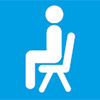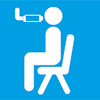Stay informed about upcoming prescribed burns
Visit the upcoming prescribed burns page, subscribe to the RSS Feed, or follow @ACT_Parks on Twitter, @ACTParks on Facebook or @ACTParks on Instagram to stay up to date on upcoming burns in the ACT.
Asthma and bushfire smoke
Smoke from prescribed burning activities can be a major trigger for people with asthma and other respiratory conditions. It's important to be prepared and know how to respond if you are exposed to smoke.
Prescribed burning occurs across the ACT by the ACT Parks and Conservation Service and the ACT Rural Fire Service. Smoke from prescribed burns in surrounding NSW can also enter the ACT.
Prescribed burns reduce fuel hazard and help protect assets, our rural landscape and our water supply. They can promote ecological diversity and improve fire fighter safety by reducing fuel loads.
The burns generally occur in spring or autumn but can take place in other parts of the year if suitable conditions exist. Every effort is made to conduct burns in weather conditions that will minimise the impact of smoke on residents. Fire managers constantly monitor weather to ensure burns will not adversely affect the community.
Outdoor smoke health impacts
PCS works closely with ACT Health and Asthma Australia. Find out how to stay safe and well if there is bushfire smoke in your area.
Tips to stay safe and well if there is bushfire smoke in your area
- Stay indoors when there is smoke (unless you are advised to evacuate).
- Close all windows and doors and block air vents.
- If you have an air conditioner, use it – set it to recycle at home and in the car.
- Avoid doing physical activity outdoors while smoke is around.
- Continue using your asthma preventer medication as prescribed by your doctor.
- Always have your asthma reliever medication (blue/grey puffer) with you. Use it as soon as you get symptoms to prevent them getting worse. If available, use a spacer as it helps get more medication into your lungs.
- If your asthma reliever medication isn’t working, or is needed 2–3 times hourly or more, seek urgent medical advice by calling 000 for an ambulance.
- Older people, children and those working at the fire front are most at risk, so be aware and if you notice someone having trouble access help fast.
- If you don’t have an Asthma Action Plan, or are unsure what to do in an asthma emergency, follow the Asthma First Aid procedure.
Asthma first aid

- Sit the person upright
- be calm and reassuring
- do not leave them alone

- Give 4 separate puffs of blue/grey reliever puffer with a spacer
- Shake the puffer
- Dispense 1 puff into the spacer
- Have them take 4 breaths from the spacer
- Repeat until 4 puffs have been taken

- Wait 4 minutes
- If there is no improvement, give 4 more separate puffs of blue/grey reliever as above OR 1 more dose of Bricanyl or Symbicort inhaler.

- If there is no improvement call for emergency assistance on 000
- Say 'ambulance' and that someone is having an asthma attack
- Keep giving 4 seperate puffs every 4 minutes until emergency assistance arrives OR 1 dose of Bricanyl or Symbicort every 4 minutes (Symbicort up to 3 more doses only)
Call emergency assistance immediately (000) if:
- the person is not breathing
- the person's asthma suddenly becomes worse, or is not improving
- a reliever is not available
- you are not sure if it is asthma
- the person is known to have anaphylaxis. Follow their Anaphylaxis Action Plan, then give them asthma first aid.
Blue/grey reliever medication is unlikley to cause harm, even if the person does not have asthma.
